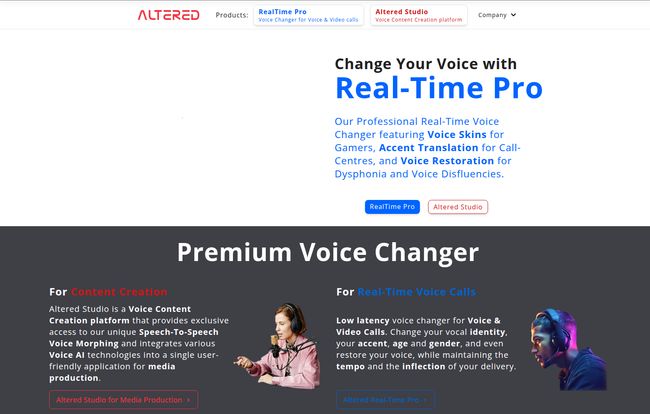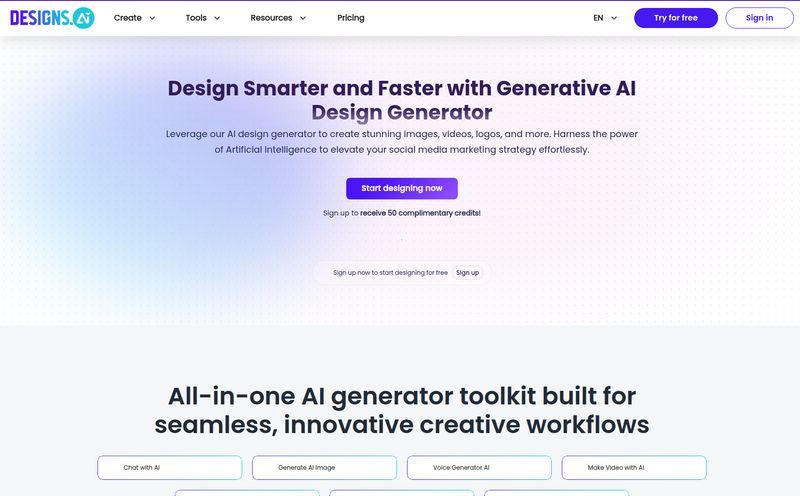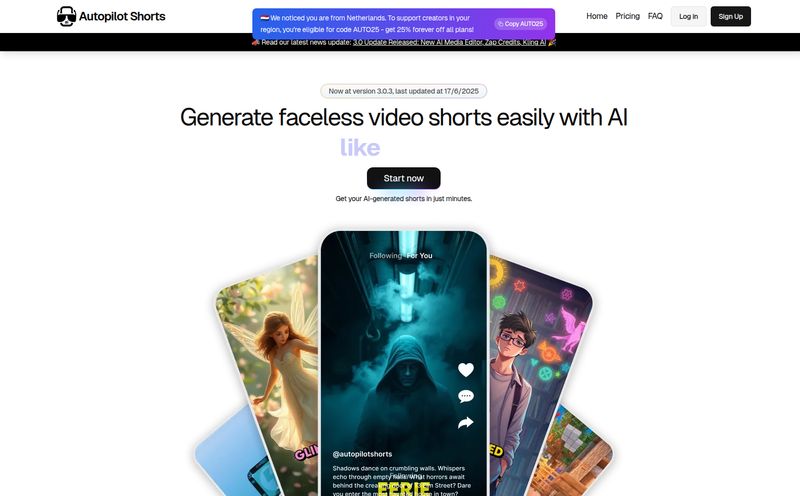As someone who’s been in the content trenches for years—wrestling with audio, cringing at my own voice on playback, and desperately trying to fix that one flubbed line at 2 AM—I've seen my fair share of 'game-changing' tools. Most of them are… well, not. They promise the world and deliver a clunky, robotic-sounding mess.
So when I first heard about Altered Studio, I was skeptical. Another AI voice tool? Great. But then I started playing with it. And a few hours later, I was still there, giggling as I morphed my voice into something completely different, and genuinely impressed. This wasn't just another pitch-shifter. This felt different.
This is my deep-dive into Altered Studio, from one creator to another. No fluff, no marketing jargon. Just what it is, what it does well, where it stumbles, and whether it’s actually worth your time and money.

Visit Altered Studio
What on Earth is Altered Studio, Anyway?
So, what's the big deal? Altered Studio isn't just a voice changer you'd use to prank your friends on Discord (though you totally could). It brands itself as a Voice AI content creation platform, and that's a pretty accurate description. Think of it less as a single tool and more like a Swiss Army knife for your voice.
It brings together a bunch of different voice technologies into one application. The centerpiece is its powerful Speech-to-Speech Voice Morphing. Instead of just making your voice higher or lower, it analyzes your performance—your cadence, your emotion, your pacing—and intelligently maps it onto a different voice. The result is surprisingly natural. It’s the difference between putting on a cheap Halloween mask and having a professional Hollywood makeup artist transform your face.
It’s built for podcasters, streamers, animators, game developers, YouTubers… basically anyone who works with the human voice and wants more flexibility.
The Coolest Features I Actually Used
A long feature list is one thing, but what’s actually useful? Here’s what stood out to me during my testing.
Real-Time Voice Changing That Doesn't Stutter
Most real-time voice changers I’ve tried have a fatal flaw: latency. That tiny delay between when you speak and when you hear the changed voice is enough to throw off your entire conversation. It’s disorienting. Altered Studio’s RealTime Pro is one of the best I've encountered at minimizing this. It's not perfectly instantaneous—we're not breaking the laws of physics here—but it's close enough for smooth gaming, streaming, or even spicing up a boring Zoom call. The quality is solid, especially on the paid tiers, avoiding that tinny, robotic sound that screams 'I'm using a voice changer!'
Post-Production Voice Morphing is a Lifesaver
This is where the magic really happens, in my opinion. The 'Media Production' side of the studio lets you take an existing audio recording and completely transform it. Did you nail the delivery of a line but hate the tone? Morph it. Need to create three distinct character voices for an indie animation but can only afford one voice actor (yourself)? Done. I even used it to fix a segment in a podcast recording where my voice sounded tired and flat. A few clicks, and it had the energy I wanted it to have in the first place. It's an incredible tool for audio post-production that gives you a level of control that used to require a ton of difficult audio engineering or expensive re-shoots.
Custom Voice Cloning: A Glimpse into the Future
Alright, this is the 'wow' feature. Altered Studio allows you to clone a voice. Yours, or with permission, someone else's. You provide it with clean audio samples, and its AI builds a model of that voice. From then on, you can type text or record your own voice and have it come out sounding like the cloned voice. The creative applications are huge—imagine preserving a voice, or creating a consistent voiceover for a brand, even with different speakers. It’s also a little spooky, I'll admit, and raises all sorts of interesting questions. But from a purely technological standpoint, it’s mind-blowing.
Let's Talk Money: The Altered Studio Pricing Tiers
Price is always a major factor. I hate when sites hide their pricing, so I was happy to see Altered Studio lays it all out. It’s a bit complex, with different licenses and token systems, so I've broken it down into a simple table. A quick note: some features use "AI Tokens," which are basically credits you spend on intensive tasks like high-quality morphing or transcription.
| Plan | Price | Best For | Key Features |
|---|---|---|---|
| Free | $0 | Trying it out, non-commercial fun | Limited real-time & morphing, 10k tokens, local voice cloning. Requires attribution. |
| Real-Time | $6/month | Streamers & Gamers | Unlimited 16kHz real-time use, 25k tokens. Still requires attribution. |
| Creator | $30/month (billed annually) | Serious Content Creators (YouTubers, Podcasters) | Higher quality (24kHz), more morphing time (60 min/mo), 325k tokens, no attribution. |
| Professional | $90/month (billed annually) | Small Studios, Freelancers | Commercial License, Pro quality (48kHz), 180 min/mo morphing, 1M tokens, advanced morphing tools. |
| Enterprise | Contact Sales | Large Companies & Production Houses | Everything unlimited, custom models, API access, dedicated support. |
My take? The Creator plan feels like the sweet spot for most serious individual creators. It removes the attribution requirement (which is big for monetization) and gives you enough resources to really integrate it into your workflow. The free plan is genuinely useful for getting a feel for the platform, much more than just a crippled demo.
The Not-So-Perfect Parts (Building Trust Here)
No tool is a silver bullet, and it'd be dishonest to pretend Altered Studio doesn't have its quirks. Here are a few things to be aware of.
First and foremost, the desktop app requires an Nvidia GPU. This is a big one. If you're a Mac user or running an AMD-powered rig, you're limited to the online version, which is good but not as powerful or feature-rich as the local desktop application. This is a significant hardware limitation that will immediately exclude a chunk of potential users.
The token system, while common in AI SaaS products, can feel a bit like you're at an arcade. You're always slightly aware of your 'credits' ticking down. For heavy users, this might push you towards a higher-tier plan than you initially thought you needed. It just takes some getting use to.
Finally, while the interface is pretty clean, the sheer breadth of features means there is a bit of a learning curve. You'll want to set aside an afternoon to just... play. To click all the buttons and see what they do. It’s not plug-and-play if you want to get the absolute best results, you need to learn the instrument.
Frequently Asked Questions About Altered Studio
Can I use Altered Studio for commercial projects?
Yes, but you'll need the correct license. The Free and Real-Time plans are for non-commercial use with attribution. For any commercial work, like monetized YouTube videos or professional voice-over gigs, you'll need to be on the Professional plan or higher.
Do I need to be a sound engineer to use it?
Absolutely not. That’s one of its main strengths. While a sound engineer could definitely pull some amazing tricks with it, the user interface is designed for creators, not just technicians. It’s surprisingly intuitive for how powerful it is.
What's the difference between Voice Morphing and Text-to-Speech (TTS)?
Good question! TTS generates a voice from written text, which Altered Studio can do. Voice Morphing takes an existing vocal performance (your voice) and applies its characteristics—pacing, emotion, pitch—to a different target voice. Morphing often sounds more natural because it's based on a real human performance.
Does Altered Studio work on a Mac?
Yes and no. The web-based version of Altered Studio works on any system with a browser, including Mac. However, the more powerful desktop application, which handles some of the heavy-lifting locally, requires a Windows PC with a compatible Nvidia graphics card.
Is voice cloning... safe?
This is a hot topic in AI right now. Altered Studio's stance is built around responsible use. You're meant to use your own voice or voices you have explicit permission to use. Like any powerful tool, it's about the user's intent. The technology itself is just a tool.
The Final Verdict: Is Altered Studio Worth a Spot in Your Toolkit?
After spending a good amount of time with it, I'm moving Altered Studio from my 'skeptical' list to my 'genuinely useful' list. It's a remarkably comprehensive and high-quality suite of tools.
Is it for everyone? No. If you're a Mac user, the desktop app limitation is a real bummer. If you just need a simple, free voice filter for a laugh, there are lighter options. But if you're a content creator who is serious about audio—a podcaster tired of re-takes, a streamer wanting a unique identity, an indie dev needing character voices, or a YouTuber aiming for broadcast-quality sound—then yes. Altered Studio is absolutely worth a serious look.
It successfully bundles the functions of 3 or 4 different apps into one coherent package. The quality of the voice morphing is top-tier, and the creative doors it opens are immense. It’s a powerful, forward-thinking platform that gives a hint of where creative AI is going. And for once, I'm not skeptical about that... I'm actually excited.



